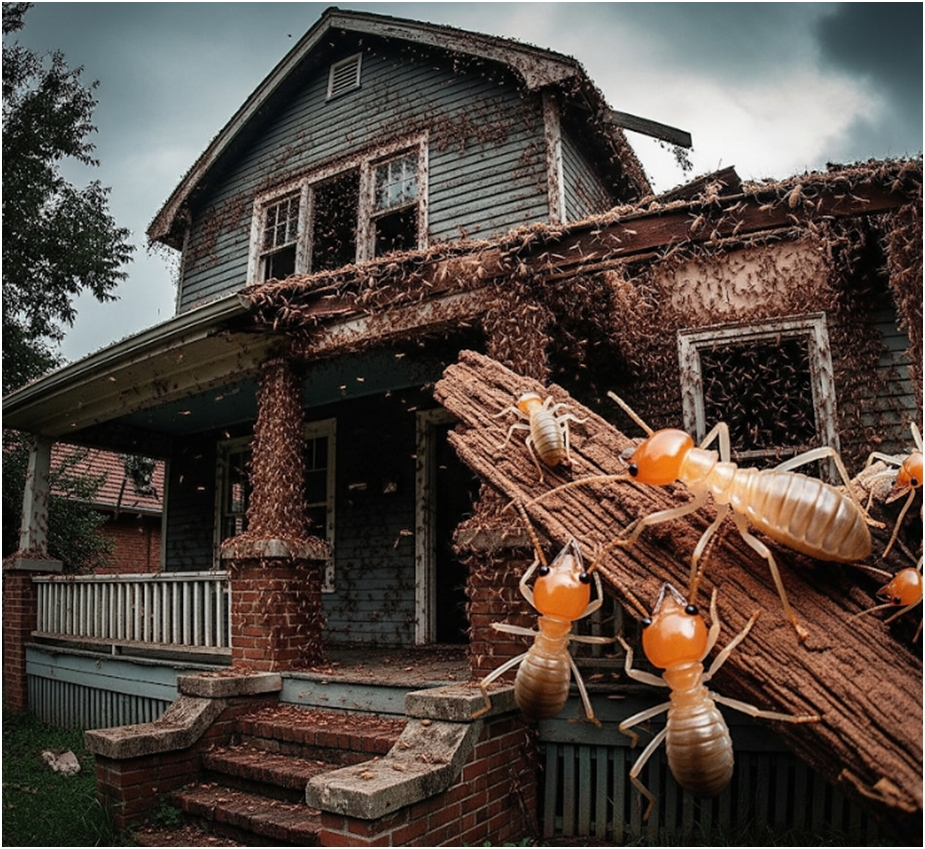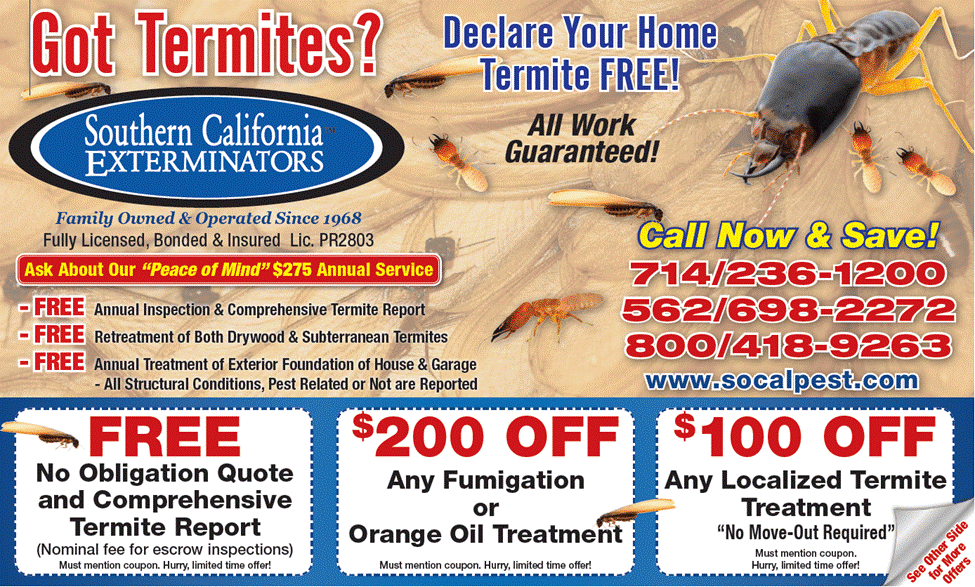What Homeowners Should Know about Termite Inspections in Corona

BOOK A TERMITE PEST INSPECTION IN CORONA AND PROCEED WITH CONFIDENCE.
SAME DAY Termite Control in Corona | We know that if you have a termite or pest problem, it’s not just about getting rid of the pests but also finding the root of the problem and making sure they don’t come back. Effective Corona pest control and exterminator services near me for homes, businesses, and more.
Schedule Your Free Inspection … Let our team of experts at Truly Nolen provide you with exceptional pest control. Call us at 714-236-1200
Pest Control Corona, CA | Guaranteed Pest Extermination
Get Your Termite & Pest Problem Fixed Today
Choose our professional termite & pest control services for guaranteed results, delivered affordably with expert precision every time. Get a free quote today. The cost of basic residential pest control services in Corona, CA can range between $70 and $200+. The average cost of a home pest control visit is $118. Get Termite Treatment in Corona · A no cost termite inspection Huntington Beach County from an experienced and trained exterminator. · A customized termite removal and prevention plan.
GET IN TOUCH WITH SO CAL PEST REMOVAL FOR ALL YOUR PEST ISSUES.
Don’t let termites and pests overrun your home or business! Contact us now to address the pest problem on your premises. Our experts will assess the situation and design a customized plan to exterminate it.
- 3 Main Types of Termites in Corona, CA
- Drywood Termites
- Where They Live: Inside dry wood such as framing, attic trusses, furniture, and hardwood floors.
- How They Get In: Can enter through exposed wood, unfinished attics, or infested furniture.
- Damage: Hollow out wood from the inside, leaving behind small holes and piles of pellet-shaped droppings (“frass”).
- Detection: Look for discarded wings, frass, and blistered wood surfaces.
- Key Risk: Infestations can go unnoticed for years and often don’t need ground contact.
- Subterranean Termites
- Where They Live: Colonies underground, moving up through mud tubes to reach wood.
- How They Get In: Enter via cracks in foundations, expansion joints, or where wood touches soil.
- Damage: Feed on load-bearing wood, beams, floors, and walls—potentially weakening the entire structure.
- Detection: Watch for mud tubes on exterior walls or foundations, sagging floors, and bubbling paint.
- Key Risk: Cause the most property damage and require moisture to survive.
- Dampwood Termites
- Where They Live: In wet, decaying, or water-damaged wood (often outside: logs, stumps, leaky areas).
- How They Get In: Attracted by moisture problems; infest wood that’s been exposed to leaks, drainage issues, or standing water.
- Damage: Chew through damp wood, including outdoor structures, firewood, and sometimes inside walls if there’s water damage.
- Detection: Look for large termites (up to ¾ inch), soft wood, or wood that appears damp and decayed.
- Key Risk: Signal underlying moisture problems around your property.
- Drywood Termites
- Signs of a Termite Infestation
- Mud tubes along foundations or garage walls (subterranean)
- Tiny holes in wood with piles of frass (drywood)
- Wood that sounds hollow when tapped
- Discarded wings near windowsills or doors
- Sagging, buckling, or blistered wooden floors and walls
- Prevention Tips
- Reduce wood-to-soil contact (keep wood siding at least 6 inches above soil).
- Fix leaks promptly—roof, plumbing, and drainage issues.
- Store firewood and mulch away from your home.
- Maintain proper ventilation in attics and crawl spaces.
- Seal foundation cracks and gaps.
- Schedule annual professional termite inspections.
- If You Suspect Termites
- Are you looking for effective termite and pest control services in Orange County? Don’t wait: untreated infestations lead to expensive repairs.
- Contact a licensed pest control expert for inspection and treatment.
- Consider preventative treatments, especially after water damage repairs.

Pest Control Exterminator in Corona, California
Need termite control in Corona? Living in Corona, California City of Corona (@city_of_corona)
comes with unique pest challenges due to the area’s warm climate. Pests such as ants, roaches, termites, and spiders thrive in these conditions, making reliable pest control essential for both homeowners and businesses. Without prompt treatment, pests like termites can cause major structural damage, while ant and insect infestations threaten food safety and create health hazards. U.S. Census Bureau QuickFacts: Corona city, California
Residential pest control maintenance in Corona averages around $118 per visit, with annual service plans ranging from $240 to $800. Commercial pest control pricing varies from $480 to $5,880 per year, depending on property size and service needs.
Dampwood Termites FAQ
What are dampwood termites? Dampwood termites are a type of termite that thrives in wet, decaying, or moisture-rich wood. Unlike subterranean termites, they do not require soil contact, but they do need high moisture levels to survive.
Where are dampwood termites commonly found? They are most commonly found in the western United States, including California. Within homes, they prefer wood that is moist or water-damaged, such as leaky roofs, plumbing, or wood-to-soil contact areas.
How do dampwood termites get into homes? Dampwood termites are attracted to areas with excessive moisture. They enter homes through wood that is in contact with soil or is consistently damp due to leaks, poor drainage, or condensation.
What does dampwood termite damage look like? They hollow out wood, creating smooth chambers and galleries. The wood may appear darker, feel damp, and break apart easily. Unlike other termites, dampwood termites do not leave mud tubes.
What are signs of a dampwood termite infestation?
- Presence of large, winged termites (alates) during swarming season
- Soft, decaying, or discolored wood
- Wood that feels hollow when tapped
- Fecal pellets, which are usually larger than those left by drywood termites
How can I prevent dampwood termites?
- Repair leaks and address sources of moisture immediately
- Ensure proper drainage away from your home’s foundation
- Keep wood, mulch, and firewood away from the home’s exterior
- Maintain well-ventilated crawl spaces and attics
- Replace any water-damaged wood
Do dampwood termites require different treatment than other termites? Yes. Eliminating the moisture source is critical. Unlike subterranean termites, soil treatments are less effective, and physical removal of infested wood and repairs, combined with localized treatment, is required.
Are dampwood termites as destructive as other types? They can cause significant damage if infestations are left untreated, but they are less likely to invade dry, sound wood compared to subterranean and drywood termites.
Who should I contact if I suspect an infestation? If you notice any signs of termites or wood damage, contact a licensed pest control professional for a thorough inspection and treatment plan.